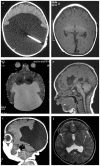Mutations in ZIC2 in human holoprosencephaly: description of a novel ZIC2 specific phenotype and comprehensive analysis of 157 individuals
- PMID: 19955556
- PMCID: PMC3208626
- DOI: 10.1136/jmg.2009.073049
Mutations in ZIC2 in human holoprosencephaly: description of a novel ZIC2 specific phenotype and comprehensive analysis of 157 individuals
Abstract
Background: Holoprosencephaly (HPE), the most common malformation of the human forebrain, may be due to mutations in genes associated with non-syndromic HPE. Mutations in ZIC2, located on chromosome 13q32, are a common cause of non-syndromic, non-chromosomal HPE.
Objective: To characterise genetic and clinical findings in patients with ZIC2 mutations.
Methods: Through the National Institutes of Health and collaborating centres, DNA from approximately 1200 individuals with HPE spectrum disorders was analysed for sequence variations in ZIC2. Clinical details were examined and all other known cases of mutations in ZIC2 were included through a literature search.
Results: By direct sequencing of DNA samples of an unselected group of unrelated patients with HPE in our NIH laboratory, ZIC2 mutations were found in 8.4% (49/582) of probands. A total of 157 individuals from 119 unrelated kindreds are described, including 141 patients with intragenic sequence determined mutations in ZIC2. Only 39/157 patients have previously been clinically described. Unlike HPE due to mutations in other genes, most mutations occur de novo and the distribution of HPE types differs significantly from that of non-ZIC2 related HPE. Evidence is presented for the presence of a novel facial phenotype which includes bitemporal narrowing, upslanting palpebral fissures, a short nose with anteverted nares, a broad and well demarcated philtrum, and large ears.
Conclusions: HPE due to ZIC2 mutations is distinct from that due to mutations in other genes. This may shed light on the mechanisms involved in formation of the forebrain and face and will help direct genetic counselling and diagnostic strategies.
Conflict of interest statement
There are no competing interests.
Figures


Similar articles
-
Holoprosencephaly: ZIC2 mutation in a case with panhypopituitarism.J Pediatr Endocrinol Metab. 2014 Jul;27(7-8):777-81. doi: 10.1515/jpem-2013-0449. J Pediatr Endocrinol Metab. 2014. PMID: 24706429
-
New findings for phenotype-genotype correlations in a large European series of holoprosencephaly cases.J Med Genet. 2011 Nov;48(11):752-60. doi: 10.1136/jmedgenet-2011-100339. Epub 2011 Sep 22. J Med Genet. 2011. PMID: 21940735 Free PMC article.
-
Rare nasal cleft in a patient with holoprosencephaly due to a mutation in the ZIC2 gene.Birth Defects Res A Clin Mol Teratol. 2014 Apr;100(4):300-6. doi: 10.1002/bdra.23216. Epub 2014 Feb 12. Birth Defects Res A Clin Mol Teratol. 2014. PMID: 24677696 Review.
-
Comparison of mutation findings in ZIC2 between microform and classical holoprosencephaly in a Brazilian cohort.Birth Defects Res A Clin Mol Teratol. 2012 Nov;94(11):912-7. doi: 10.1002/bdra.23047. Epub 2012 Jul 27. Birth Defects Res A Clin Mol Teratol. 2012. PMID: 22847929 Free PMC article.
-
ZIC2 in Holoprosencephaly.Adv Exp Med Biol. 2018;1046:269-299. doi: 10.1007/978-981-10-7311-3_14. Adv Exp Med Biol. 2018. PMID: 29442327 Review.
Cited by
-
Clinical and neuroimaging review of triplet repeat diseases.Jpn J Radiol. 2023 Feb;41(2):115-130. doi: 10.1007/s11604-022-01343-5. Epub 2022 Sep 28. Jpn J Radiol. 2023. PMID: 36169768 Free PMC article. Review.
-
A broad range of ophthalmologic anomalies is part of the holoprosencephaly spectrum.Am J Med Genet A. 2011 Nov;155A(11):2713-20. doi: 10.1002/ajmg.a.34261. Epub 2011 Oct 4. Am J Med Genet A. 2011. PMID: 21976454 Free PMC article.
-
Zic2 hypomorphic mutant mice as a schizophrenia model and ZIC2 mutations identified in schizophrenia patients.Sci Rep. 2011;1:16. doi: 10.1038/srep00016. Epub 2011 Jun 17. Sci Rep. 2011. PMID: 22355535 Free PMC article.
-
Importance of complete phenotyping in prenatal whole exome sequencing.Hum Genet. 2018 Feb;137(2):175-181. doi: 10.1007/s00439-017-1860-1. Epub 2018 Feb 1. Hum Genet. 2018. PMID: 29392406
-
Extracephalic manifestations of nonchromosomal, nonsyndromic holoprosencephaly.Am J Med Genet C Semin Med Genet. 2018 Jun;178(2):246-257. doi: 10.1002/ajmg.c.31616. Epub 2018 May 15. Am J Med Genet C Semin Med Genet. 2018. PMID: 29761634 Free PMC article. Review.
References
-
- Matsunaga E, Shiota K. Holoprosencephaly in human embryos: epidemiologic studies of 150 cases. Teratology. 1977;16:261–72. - PubMed
-
- Leoncini E, Baranello G, Orioli IM, Annerén G, Bakker M, Bianchi F, Bower C, Canfield MA, Castilla EE, Cocchi G, et al. Frequency of holoprosencephaly in the International Clearinghouse Birth Defects Surveillance Systems: Searching for population variations. Birth Defects Res A Clin Mol Teratol. 2008;82:585–591. - PubMed
-
- Muenke M, Beachy PA. Genetics of ventral forebrain development and holoprosencephaly. Curr Opin Genet Dev. 2000;10:262–269. - PubMed
-
- Cohen MM., Jr Holoprosencephaly: clinical, anatomic, and molecular dimensions. Birth Defects Res A Clin Mol Teratol. 2006;76:658–673. - PubMed
Publication types
MeSH terms
Substances
Grants and funding
LinkOut - more resources
Full Text Sources
Medical
